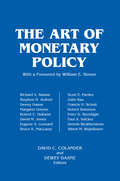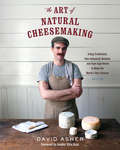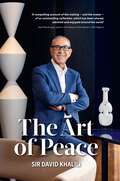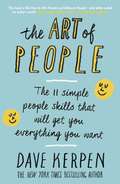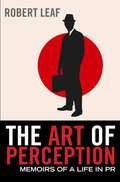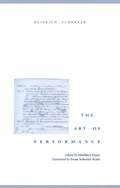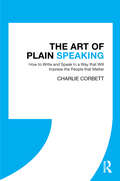- Table View
- List View
The Art of Looking: How to Read Modern and Contemporary Art
by Lance EsplundA veteran art critic helps us make sense of modern and contemporary artThe landscape of contemporary art has changed dramatically during the last hundred years: from Malevich's 1915 painting of a single black square and Duchamp's 1917 signed porcelain urinal to Jackson Pollock's midcentury "drip" paintings; Chris Burden's "Shoot" (1971), in which the artist was voluntarily shot in the arm with a rifle; Urs Fischer's "You" (2007), a giant hole dug in the floor of a New York gallery; and the conceptual and performance art of today's Ai Weiwei and Marina Abramovic. The shifts have left the art-viewing public (understandably) perplexed.In The Art of Looking, renowned art critic Lance Esplund demonstrates that works of modern and contemporary art are not as indecipherable as they might seem. With patience, insight, and wit, Esplund guides us through the last century of art and empowers us to approach and appreciate it with new eyes. Eager to democratize genres that can feel inaccessible, Esplund encourages viewers to trust their own taste, guts, and common sense. The Art of Looking will open the eyes of viewers who think that recent art is obtuse, nonsensical, and irrelevant, as well as the eyes of those who believe that the art of the past has nothing to say to our present.
The Art of Looking: How to Read Modern and Contemporary Art
by Lance EsplundA veteran art critic helps us make sense of modern and contemporary art The landscape of contemporary art has changed dramatically during the last hundred years: from Malevich's 1915 painting of a single black square and Duchamp's 1917 signed porcelain urinal to Jackson Pollock's midcentury "drip" paintings; Chris Burden's "Shoot" (1971), in which the artist was voluntarily shot in the arm with a rifle; Urs Fischer's "You" (2007), a giant hole dug in the floor of a New York gallery; and the conceptual and performance art of today's Ai Weiwei and Marina Abramovic. The shifts have left the art-viewing public (understandably) perplexed. In The Art of Looking, renowned art critic Lance Esplund demonstrates that works of modern and contemporary art are not as indecipherable as they might seem. With patience, insight, and wit, Esplund guides us through the last century of art and empowers us to approach and appreciate it with new eyes. Eager to democratize genres that can feel inaccessible, Esplund encourages viewers to trust their own taste, guts, and common sense. The Art of Looking will open the eyes of viewers who think that recent art is obtuse, nonsensical, and irrelevant, as well as the eyes of those who believe that the art of the past has nothing to say to our present.
The Art of Making Sh!t Up: Using the Principles of Improv to Become an Unstoppable Powerhouse
by Norm LavioletteWork together to up your chances of business success The Art of Making Sh!t Up combines the lessons learned from a personal journey with the teachings derived from years of honing valuable skills through performing and presenting to thousands of people to demonstrate how working together has helped others found and grow several multimillion-dollar companies. By focusing on topics that serve as pain points and detailing the tools and techniques of improv, this book helps people and organizations utilize new skill sets to be more productive, more accepting, and more "all in" to create a stronger teammate and team. Remove the fear of failure Recognize when and how to trust your instincts Celebrate and embrace the ideas of others Listen effectively—to both people and your environment Thinking is hard. Listening is easy—and is most often the springboard to huge ideas. Find out how it can work for you with The Art of Making Sh!t Up.
The Art of Making Sh!t Up: Using the Principles of Improv to Become an Unstoppable Powerhouse
by Norm LavioletteWork together to up your chances of business success The Art of Making Sh!t Up combines the lessons learned from a personal journey with the teachings derived from years of honing valuable skills through performing and presenting to thousands of people to demonstrate how working together has helped others found and grow several multimillion-dollar companies. By focusing on topics that serve as pain points and detailing the tools and techniques of improv, this book helps people and organizations utilize new skill sets to be more productive, more accepting, and more "all in" to create a stronger teammate and team. Remove the fear of failure Recognize when and how to trust your instincts Celebrate and embrace the ideas of others Listen effectively—to both people and your environment Thinking is hard. Listening is easy—and is most often the springboard to huge ideas. Find out how it can work for you with The Art of Making Sh!t Up.
The Art of Management and the Aesthetic Manager: The Coming Way of Business
by John DobsonBusinesses that tend to flourish during any given time period usually reflect the aspirations and attitudes of the prevailing culture. More specifically, the managers within these businesses reflect these characteristics. The challenge to management therefore is to read and interpret subtle cultural shifts and to understand how these shifts impact the role of business in society. These facts beg the questions What is the prevailing culture of the twenty-first century going to be? and How is this culture going to be reflected in the attitudes and aspirations of business management? The author of this remarkable book argues that the dominant culture will best be described as aesthetic in nature. The manager views his or her role as essentially artistic, seeking excellence in the craft rather than the pursuit of profit as the highest good.Parts one and two describe the existing models of management, the technical manager and the moral manager, and explain why they are no longer suitable. Then, incorporating business ethics, postmodern theory, virtue-ethics theory, and examples drawn from industry, Dobson convincingly argues the emergence of a new management paradigm. Part three describes the new model of management as artistic and aesthetic enterprise and the manager as artisan. Business scholars and theorists, practicing managers, and students will all find this book fascinating and useful in preparing for business in the coming century.
The Art of Mastering Sales Management
by Thomas A. CookIf you believe that the answer no is but a request for more information and understand that the best closing questions are rhetorical, you understand the basic art of sales. If you can teach that art to others, you have the makings of a good sales manager. But not all good sales managers are equal; some are forward thinking enough to be good leader
The Art of Monetary Policy
by David C. Colander Dewey DaaneOffering an introduction to the Japanese political system, this book covers the end of the Koizumi era, the brief and troubled premiership of Abe, and the selection of Fukuda as prime minister. It includes material on "bubble" and "post-bubble" economic developments, as well as coverage of health care policy.
The Art of Monetary Policy
by David C. Colander Dewey DaaneOffering an introduction to the Japanese political system, this book covers the end of the Koizumi era, the brief and troubled premiership of Abe, and the selection of Fukuda as prime minister. It includes material on "bubble" and "post-bubble" economic developments, as well as coverage of health care policy.
The Art of Mooting: Theories, Principles and Practice
by Mark Thomas Lucy CradduckAdvocacy skills, which are learnt in the moot court, as a precursor to the effective communication of persuasive legal argument, are essential for those seeking a career in law. The skills associated with successful mooting, cover the entire range of the domains of human activity: intellectual, physical and emotional. This informative book examines the theories relevant to the development of skills necessary for effective participation in competition moots. By consideration of underlying theories, Mark Thomas and Lucy Cradduck develop unique models of the skills of the cognitive, psychomotor and affective domains and effective team dynamics, emphasising the importance of written submissions. The authors use this analysis to develop a unique integrated model that informs the process of coaching moot teams according to reliable principles. The Art of Mooting distils the theories and principles that support successful moot performances, grounding these in practical examples of how a mooter’s skills may be developed and improved. It is an essential guide for moot coaches, law and advocacy students and academics seeking to improve their skills, and new and existing practitioners.
The Art of Natural Cheesemaking: Using Traditional, Non-Industrial Methods and Raw Ingredients to Make the World's Best Cheeses
by David Asher Sandor Ellix KatzIncluding more than 35 step-by-step recipes from the Black Sheep School of Cheesemaking Most DIY cheesemaking books are hard to follow, complicated, and confusing, and call for the use of packaged freeze-dried cultures, chemical additives, and expensive cheesemaking equipment. For though bread baking has its sourdough, brewing its lambic ales, and pickling its wild fermentation, standard Western cheesemaking practice today is decidedly unnatural. In The Art of Natural Cheesemaking, David Asher practices and preaches a traditional, but increasingly countercultural, way of making cheese—one that is natural and intuitive, grounded in ecological principles and biological science. This book encourages home and small-scale commercial cheesemakers to take a different approach by showing them: • How to source good milk, including raw milk; • How to keep their own bacterial starter cultures and fungal ripening cultures; • How make their own rennet—and how to make good cheese without it; • How to avoid the use of plastic equipment and chemical additives; and • How to use appropriate technologies. Introductory chapters explore and explain the basic elements of cheese: milk, cultures, rennet, salt, tools, and the cheese cave. The fourteen chapters that follow each examine a particular class of cheese, from kefir and paneer to washed-rind and alpine styles, offering specific recipes and handling advice. The techniques presented are direct and thorough, fully illustrated with hand-drawn diagrams and triptych photos that show the transformation of cheeses in a comparative and dynamic fashion. The Art of Natural Cheesemaking is the first cheesemaking book to take a political stance against Big Dairy and to criticize both standard industrial and artisanal cheesemaking practices. It promotes the use of ethical animal rennet and protests the use of laboratory-grown freeze-dried cultures. It also explores how GMO technology is creeping into our cheese and the steps we can take to stop it. This book sounds a clarion call to cheesemakers to adopt more natural, sustainable practices. It may well change the way we look at cheese, and how we make it ourselves.
The Art of Opportunity: How to Build Growth and Ventures Through Strategic Innovation and Visual Thinking
by Marc Sniukas Parker Lee Matt MoraskyInnovate your way toward growth using practical, research-backed frameworks The Art of Opportunity offers a path toward new growth, providing the perspective and methods you need to make innovation happen. Written by a team of experts with both academic and industry experience—and a client roster composed of some of the world’s leading companies—this book provides you with the necessary tools to help you capture growth instead of chasing it. The visual frameworks and research-based methodology presented in The Art of Opportunity merge business design thinking and strategic innovation to help you change your growth paradigm. You’ll learn creative and practical methods for exploring growth opportunities and employ a new approach for identifying what “opportunity” looks like in the first place. Put aside the old school way of focusing on new products and new markets, to instead applying value creation to find your new opportunity, craft your offering, design your strategy and build new growth ventures. The changing business ecosystem is increasingly pushing traditional thinking out to pasture. New consumers and the new marketplace are demanding a profound adjustment to the way companies plan and execute growth strategies. This book gives you the tools to create your roadmap toward the new state of growth, and gain invaluable insight into a new way of thinking. The Art of Opportunity will help you to: Start looking at business growth from a new perspective Create value for the customers, company and ecosystem Innovate strategically and design new business models Develop a new active business design thinking approach to innovation Your company’s goal is to grow, and to turn non-customers into customers. The old ways are becoming less tenable and less cost-effective. The Art of Opportunity outlines the new growth paradigm and gives you a solid framework for putting new ideas into practice.
The Art of Opportunity: How to Build Growth and Ventures Through Strategic Innovation and Visual Thinking
by Marc Sniukas Parker Lee Matt MoraskyInnovate your way toward growth using practical, research-backed frameworks The Art of Opportunity offers a path toward new growth, providing the perspective and methods you need to make innovation happen. Written by a team of experts with both academic and industry experience—and a client roster composed of some of the world’s leading companies—this book provides you with the necessary tools to help you capture growth instead of chasing it. The visual frameworks and research-based methodology presented in The Art of Opportunity merge business design thinking and strategic innovation to help you change your growth paradigm. You’ll learn creative and practical methods for exploring growth opportunities and employ a new approach for identifying what “opportunity” looks like in the first place. Put aside the old school way of focusing on new products and new markets, to instead applying value creation to find your new opportunity, craft your offering, design your strategy and build new growth ventures. The changing business ecosystem is increasingly pushing traditional thinking out to pasture. New consumers and the new marketplace are demanding a profound adjustment to the way companies plan and execute growth strategies. This book gives you the tools to create your roadmap toward the new state of growth, and gain invaluable insight into a new way of thinking. The Art of Opportunity will help you to: Start looking at business growth from a new perspective Create value for the customers, company and ecosystem Innovate strategically and design new business models Develop a new active business design thinking approach to innovation Your company’s goal is to grow, and to turn non-customers into customers. The old ways are becoming less tenable and less cost-effective. The Art of Opportunity outlines the new growth paradigm and gives you a solid framework for putting new ideas into practice.
The Art of Options Trading in Australia
by Christopher TateThe exchange-traded options market is one of the most dynamic and innovative markets in Australia, and options themselves are among the most profitable tools available to traders. While traditional investors can only make a profit when the market is rising, traders in options can make money whether the market is moving up or down. The leverage they provide also allows traders to control a large amount of stock with a comparatively small amount of money. In The Art of Options Trading in Australia, experienced and highly successful options trader Christopher Tate shows you how to make the most of these valuable tools. Starting with the basics of defining options, Chris goes on to look at: How options are priced, and what factors influence this Reading option quotes and payoff diagrams How the passing of time and changes in volatility affect options The 'Greeks' and how to use them Using the internet to assist your options trading Spreads, straddles and strangles Warrants, and the different types available.
The Art of Options Trading in Australia
by Christopher TateThe exchange-traded options market is one of the most dynamic and innovative markets in Australia, and options themselves are among the most profitable tools available to traders. While traditional investors can only make a profit when the market is rising, traders in options can make money whether the market is moving up or down. The leverage they provide also allows traders to control a large amount of stock with a comparatively small amount of money. In The Art of Options Trading in Australia, experienced and highly successful options trader Christopher Tate shows you how to make the most of these valuable tools. Starting with the basics of defining options, Chris goes on to look at: How options are priced, and what factors influence this Reading option quotes and payoff diagrams How the passing of time and changes in volatility affect options The 'Greeks' and how to use them Using the internet to assist your options trading Spreads, straddles and strangles Warrants, and the different types available.
The Art of Organisational Resilience: Revisiting the Fall of France in 1940
by Elmar KutschThe battlefield of the past is an opportunity for the future commander, the future manager to reflect. The books rationale for translating military concepts into management speak is the authors impression in the classroom that managers in commercial organisations tend to follow ‘outdated’ models of management, without reflecting on a military science that is believed to provide thought leadership. The case study of the Fall of France in 1940 is a contest between two archetypes of organisational resilience, with one prevailing over the other. The resulting insights shaped military science; concepts such as Auftragstaktik have found its way into doctrinal thinking of modern armies as well as framed contemporary management literature. This book provides a compelling analysis of the monumental events in May 1940, and provides rudimentary answers from a military and management perspective, true to the premise of history. The Art of Organisational Resilience is a highly distinctive and readable book that explores the strategy, operations and tactics of modern business and the role of resilience in sustaining business in increasingly complex, often fast-changing and adverse conditions.
The Art of Organisational Resilience: Revisiting the Fall of France in 1940
by Elmar KutschThe battlefield of the past is an opportunity for the future commander, the future manager to reflect. The books rationale for translating military concepts into management speak is the authors impression in the classroom that managers in commercial organisations tend to follow ‘outdated’ models of management, without reflecting on a military science that is believed to provide thought leadership. The case study of the Fall of France in 1940 is a contest between two archetypes of organisational resilience, with one prevailing over the other. The resulting insights shaped military science; concepts such as Auftragstaktik have found its way into doctrinal thinking of modern armies as well as framed contemporary management literature. This book provides a compelling analysis of the monumental events in May 1940, and provides rudimentary answers from a military and management perspective, true to the premise of history. The Art of Organisational Resilience is a highly distinctive and readable book that explores the strategy, operations and tactics of modern business and the role of resilience in sustaining business in increasingly complex, often fast-changing and adverse conditions.
The Art of Peace
by Sir David KhaliliIn 1967, Sir David Khalili finished his military service in Iran and travelled to study in the United States with $750 - his remaining royalties from a book he wrote when he was just 14. Over the course of the next five decades he single-handedly, piece by piece, assembled eight of the finest art collections in their field, ultimately becoming one of the world's greatest collectors, about whom Queen Elizabeth II once said: 'It is scary how much this gentleman knows about art.'For the first time, Sir David shares his extraordinary journey: one that has taken him through the souks of North Africa, the auction houses of Europe and the United States, the bazaars of South Asia, and far beyond. Through a riveting collection of real-life adventures, he reveals his collecting strategy, business ethics and what motivates him to continuously collect, conserve, research, publish and exhibit the treasures in his collections. Through his story, Sir David questions how the undeniable power of art can be harnessed to foster greater peace and unity worldwide. No one is better placed to enlighten us.
The Art of People: The 11 Simple People Skills That Will Get You Everything You Want
by Dave KerpenWhat does it take to win success and influence? In a world where we are constantly connected, it's those with the best people skills who win the day. Those who build the right relationships. Those who truly understand and connect with their colleagues, their customers, their partners. Those who others like, respect and trust.The Art of People reveals the eleven people skills that will get you more of what you want at work, at home and in life. Accessible, easy to execute and often counter-intuitive, these include:- The single most important question you can ever ask to win attention in a meeting- Why it usually pays to be the one to give the bad news- How to get everyone to want to be around you, with one word No matter who you are or what profession you're in, The Art of People will show you how to charm and win over anyone. 'This book is like How to Win Friends and Influence People - only better suited for today's world' - ADAM GRANT, author of Give and Take and Originals'People skills can't be computerized, outsourced, or reduced to a rubric. That's why The Art of People is more important now than ever - it will teach you a set of irreplaceable skills that will help you in every area of your life' - DANIEL H. PINK, author of To Sell Is Human and Drive
The Art of Perception: Memoirs of a Life in PR
by Robert LeafThe Art of Perception is the memoir of the man who has been at the forefront of the PR industry for almost fifty years. Robert Leaf, the first executive to bring PR to the Soviet and Chinese governments during the Cold War, has accomplished more than anyone else. He advised corporations and heads of state, rubbed shoulders with some of the twentieth century's most powerful individuals, and controlled some of the biggest news stories of the time. Now, in an age of twenty-four hour news cycles in which global disasters are shared on the most personal levels and events make it from smartphone to headline news in seconds, perception management has never been more essential for individuals and corporations alike. In a memoir which is as informative as it is entertaining, Robert Leaf shares a lifetime's experience in spreading the gospel of PR around the world which will prove invaluable as much for those in PR as to those with an interest in modern media.
The Art Of Performance
by Heinrich Schenker Heribert Esser Irene Schreier ScottHeinrich Schenker'sThe Art of Performanceshows this great music theorist in a new light. While his theoretical writings helped transform music theory in the twentieth century, this book draws on his experience as a musician and teacher to propose a sharp reevaluation of how musical compositions are realized in performance. Filled with concrete examples and numerous suggestions, the book will interest both music theorists and practicing performers. Schenker's approach is based on his argument that much of contemporary performance practice is rooted in the nineteenth-century cult of the virtuoso, which has resulted in an overemphasis on technical display. To counter this, he proposes specific ways to reconnect the composer's intentions and the musician's performance. Schenker begins by showing how performers can benefit from understanding the laws of composition. He demonstrates how a literal interpretation of the composer's indications can be self-defeating, and he provides a lively discussion of piano technique, including suggestions for pedal, sound color, orchestral effects, and balance. He devotes separate chapters to non-legato, legato, fingering, dynamics, tempo, and rests. In addition to the examples for pianists, Schenker covers a number of topics, such as bowing technique, that will prove invaluable for other instrumentalists and for conductors. The book concludes with an aphoristic and sometimes lyrical chapter on practicing. After Schenker's death, his student Oswald Jonas prepared the text for publication from Schenker's notes, eventually leaving the manuscript to his stepdaughter, Irene Schreier Scott, who entrusted the work of organizing and editing the disparate material to Jonas's friend and student Heribert Esser. She later translated it into English. This edition is the first publication in any language of this remarkable work.
The Art of Plain Speaking: How to Write and Speak in a Way that Will Impress the People that Matter
by Charlie CorbettThis is a guide for anyone who wants to connect better with people in the workplace by speaking clearly and with purpose. It is a result of five years at Charlie Corbett’s consultancy, Bullfinch Media, where he helped convince executives that speaking plainly, thoughtfully, and behaving with humanity, is the best way to win business, boost morale and advance careers. It provides carefully detailed wisdom on how to write well, speak publicly and stand out in your job, as well as how to craft compelling communications, make the best of social media and handle the press. The Art of Plain Speaking aims to improve the experience faced by many in the modern workplace, a world where senior management are entirely absent from the shop floor – replaced by indecipherable emails from HR – and where people speak in esoteric corporate riddles, believing that sounding clever is more productive than speaking clearly.
The Art of Plain Speaking: How to Write and Speak in a Way that Will Impress the People that Matter
by Charlie CorbettThis is a guide for anyone who wants to connect better with people in the workplace by speaking clearly and with purpose. It is a result of five years at Charlie Corbett’s consultancy, Bullfinch Media, where he helped convince executives that speaking plainly, thoughtfully, and behaving with humanity, is the best way to win business, boost morale and advance careers. It provides carefully detailed wisdom on how to write well, speak publicly and stand out in your job, as well as how to craft compelling communications, make the best of social media and handle the press. The Art of Plain Speaking aims to improve the experience faced by many in the modern workplace, a world where senior management are entirely absent from the shop floor – replaced by indecipherable emails from HR – and where people speak in esoteric corporate riddles, believing that sounding clever is more productive than speaking clearly.
The Art of Planning: Selected Essays of Harvey S. Perloff (Environment, Development and Public Policy: Cities and Development)
by Leland S. Burns John FriedmannThe work of Harvey S. Perloff stands as a landmark in the evolution of Anglo American planning doctrine. It is impossible to fully capture the essence of the published work in a paragraph, page, or even an entire essay. Yet its highpoints can be identified. His work was innovative, reformist, comprehensive, and ori ented toward the future. In emphasizing the greater importance of people com pared to things, Perloff repeatedly prodded planners to be concerned with human needs and values. He was critical of the past. But inasmuch as he de voted more effort to envisioning what could lie ahead than in recalling the past, his work was markedly optimistic. He once admitted in writing to his "built-in weakness for expecting rational, socially oriented solutions ultimately to win out, no matter what the objective situation seems to be. " To some the expecta tion may be seen as naive; to others, as a faith in the wisdom of humankind to take the best course. However received, Perloff's optimism served as a powerful stimulant to keep moving ahead for the best that would come of it. Institutions and the ways they should be shaped and reshaped were of central concern, for institutions (though he rarely used the term) were the in struments through which "knowledge was translated into action.
The Art of Presenting: Getting It Right in the Post-Modern World
by Alan GilliesThis informal, fun guide is ideal for anyone involved in public speaking; addressing a group of people in a wide range of situations including lecturing as part of your day job, presenting research findings to your academic peers, and presenting to potential future colleagues as part of an interview process. These situations are all different, and as with many things, context is everything. Whether you’re working with large or small audiences, there are basic rules for speaking that should never be overshadowed by bewildering presentation technology.
The Art of Presenting: Getting It Right in the Post-Modern World
by Alan GilliesThis informal, fun guide is ideal for anyone involved in public speaking; addressing a group of people in a wide range of situations including lecturing as part of your day job, presenting research findings to your academic peers, and presenting to potential future colleagues as part of an interview process. These situations are all different, and as with many things, context is everything. Whether you’re working with large or small audiences, there are basic rules for speaking that should never be overshadowed by bewildering presentation technology.




